

The sand-shale depositional model used in these notes is the one proposed by P. Vail and coauthors (1977), in which it is assumed that :
1) Eustasy is the main factor driving the cyclicity of the sedimentary deposits ;
2) Sedimentary intervals have high completeness ;
3) Eustasy, Subsidence, Accommodation, Terrigeneous Influx and Climate are the major geological parameters affecting stratal patterns ;
4) Rates of Subsidence and Terrigeneous Influx are smaller than the rate sea level changes, i.e., Eustasy ;
5) Terrigeneous Influx is constant in time and space ;
6) Subsidence increases, gradually, and, linearly, basinward ;
7) The time interval between each chronostratigraphic line is 100 k years: in geologic time, depositional events are instantaneous and catastrophic.
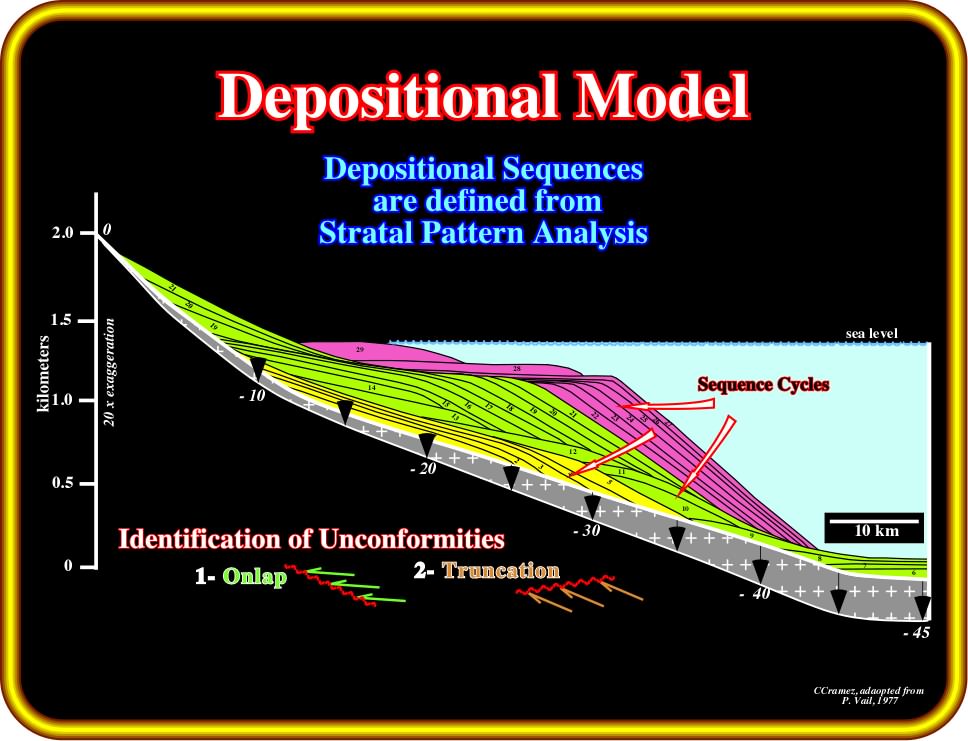
Plate 122 - As we will see later, the building block of sequential stratigraphy is a sequence-cycle, i.e., a succession of genetically related reflections bounded by unconformities or their correlative conformities composed by strata deposited during a 3rd order cycle of sea level change between two consecutive relative sea level falls of (Mitchum et al., 1977). In this depositional model, it is easy to recognize a complete typical stratigraphic sequence-cycle between chronostratigraphic intervals 8 and 21 (colored in green). The intervals colored in yellow and violet are incomplete sequence-cycles. All these sequence-cycles are bounded by unconformities (erosional surfaces) defined by onlap and truncation and/or stratal terminations.
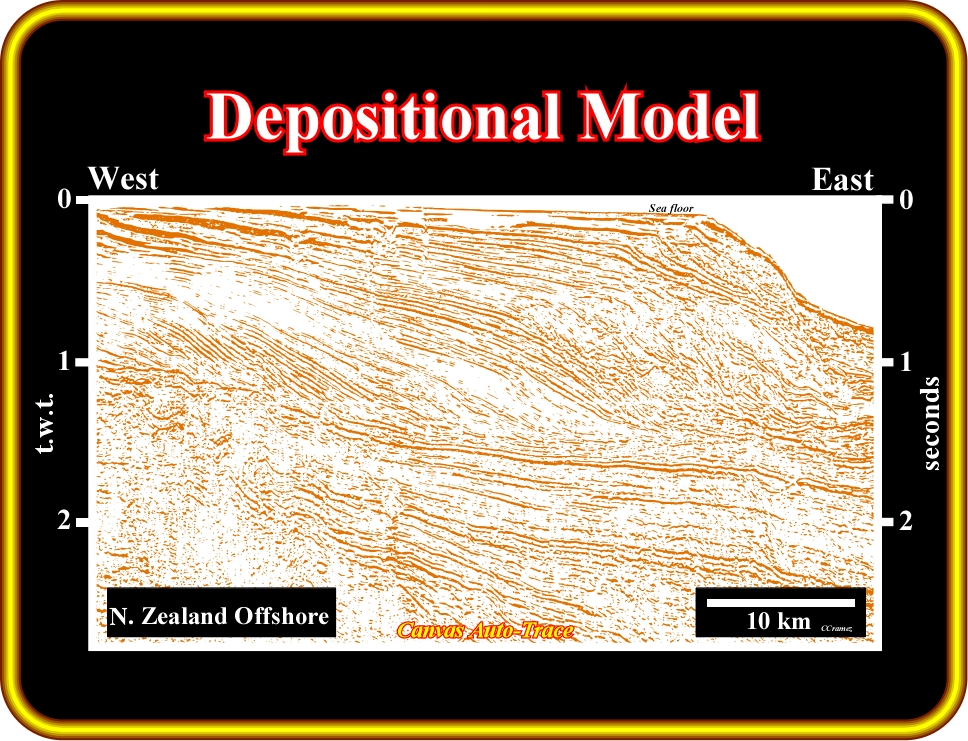
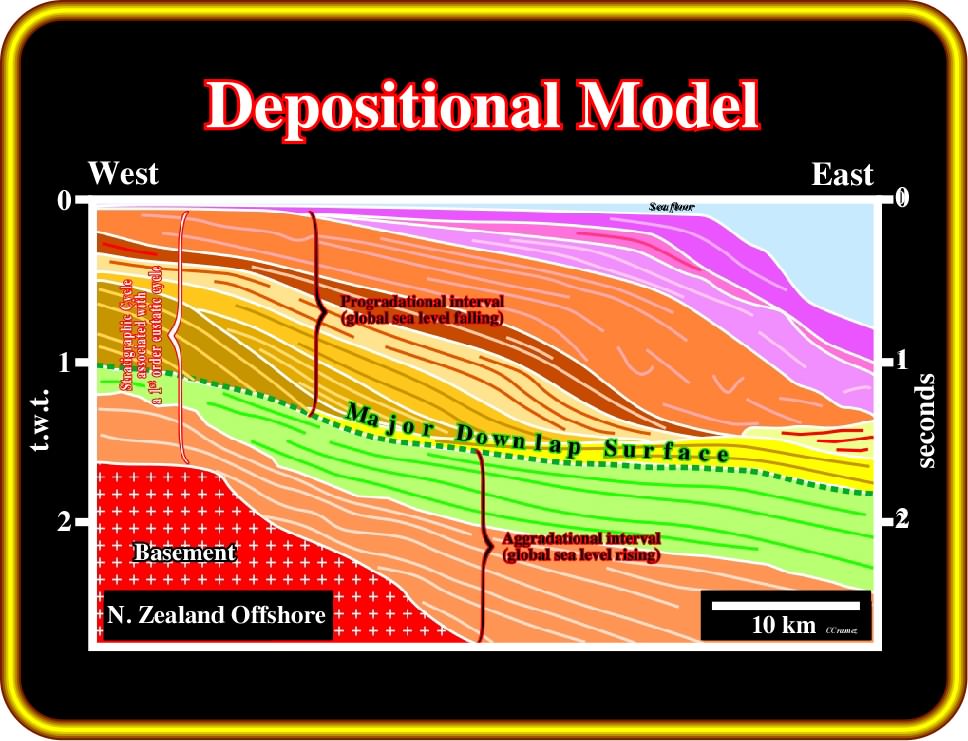
Plate 123- Seismic lines, like the one of this auto-trace, which tentative geological interpretation is here depicted have confused a lot of seismic interpreters, who used mega and super-sequences (Vail et al., 1977) to advance lithological predictions. They erroneously considered mega and super-sequences as big sequence-cycles. They assumed the presence of mega and super-turbidite intervals, as a sequence-cycle. The basic Exxon depositional model, i.e., the building block of sequential stratigraphy is the stratigraphic cycle (sequence-cycle) deposited in association with a 3rd order eustatic cycle. Such stratigraphic cycle is composed by depositional systems tracts, which allow lithological prediction, since each depositional system is characterized by a lithology and an associated typical fauna. Lithological predictions can be only advanced when seismic interpretation is performed at this high hierarchical level. Stratigraphic cycles associated with 2nd and 1storder eustatic cycles, as illustrated above, are composed by aggradational (absolute sea level rise) and progradational intervals (absolute sea level fall), in which several higher hierarchical stratigraphic intervals can be recognized.
Stratigraphic Concepts (P. Vail, 1989)
a) Clastic sediments are deposited in layers, called strata or beds. This layering results from the tendency of water or wind spreading similar sediment types in a, relatively, thin sheet over a broad are a during a period of similar environmental conditions.
When the environmental conditions change at the site of deposition, several things may happen:
- Different sediment types may be deposited on top of the previous layer ;
- There may be a period where no sediments are deposited ;
- The original layer may be eroded.In any event, because of their common depositional environment, sediment types tend to be much more similar within layers than between layers.
b) Although sediments tend to be more similar within a layer than across layers, this lateral continuity has finite limits. A particular layer may be thin and pinch-out laterally, leaving no particular record of the time of deposition in the pinch-out region. The sediment types characterizing the layer may, gradually, grade, laterally, into other sediment types within the same layer, suggesting that depositional environments also change really in a gradual fashion.
c) Certain combinations of depositional environments foster abrupt discontinuity of layers of similar sediment types. River laid sands and shales are commonly discontinuous because of repeated channeling and over-bank flooding. Other environments lead to more continuous layers as pelagic shales in deep marine basins are a good example.
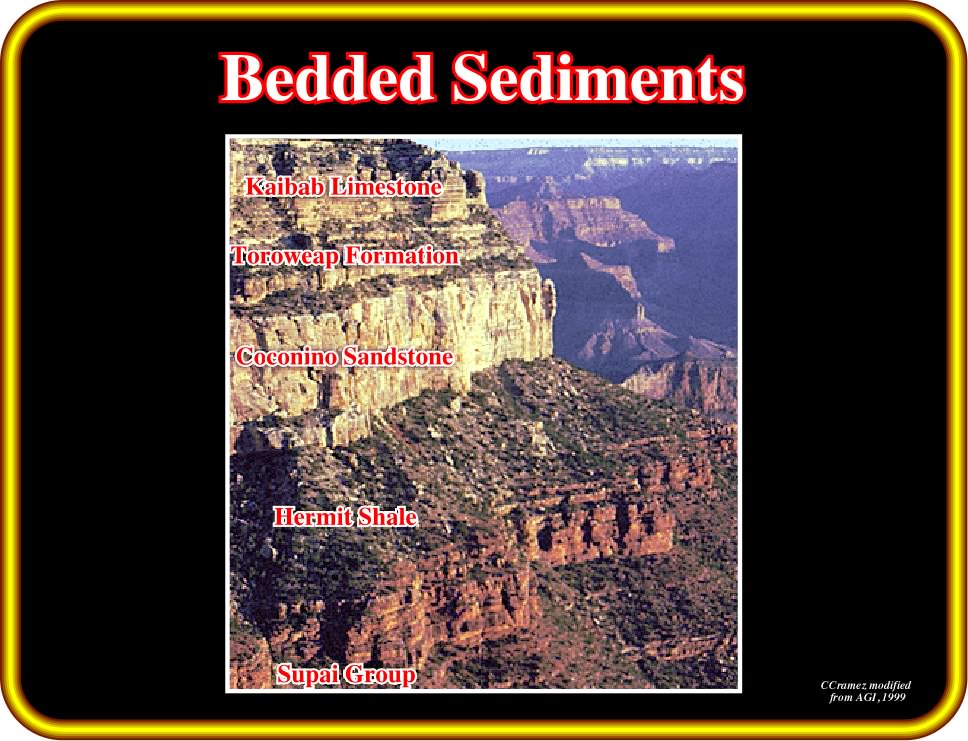
Fig. 124- In stratigraphy, bedded means formed, arranged or deposited in layers or beds or made up of or occurring in the form of beds. On this photograph, beds or strata are grouped in formations (Kaibab limestones, Toroweap, Coconino, Hermit shale and Supai group formation), which have similar rock-types. In Earth Sciences strata is sometimes, wrongly, used as a singular noun. Strata is the plural of stratum. On this photo, the strata of Coconino formation are mainly sandstones and each stratum is ,in average, 50 centimeter thick.
d) Layers of similar sediments are of variable lateral extent, but almost, universally, have greater lateral extent than vertical. These relationships have useful applications.
e) At the practical scale of well logs and seismic interpretation, these layers can be correlated to define units of sediments deposited within a common span of time.
Such correlations are called chronostratigraphic or more simply time-stratigraphic to distinguish them from rock-stratigraphic correlations, which define physical units of common rock type deposited under a common range of depositional environments independent of layering.
f) Well log correlation of chronostratigraphic layers is very dependent on the continuity of sediment types within strata. Seismic correlation, fortunately, gives a much better view of large scale chronostratigraphic layering in discontinuous sediments than do well logs, but seismic resolution of individual layers is limited when compared to well logs. The two media should be used as mutually helpful tools for chronostratigraphic correlation. Detailed ties of individual thin layers from logs to seismic sections is a critical step in the use of the two media.
g) Stratal surfaces typically represent relatively small time-gaps.
- If the time-gap is large, the surface is called an unconformity. Such a time-gap often receives the name of hiatus, indicating that it might have represented the time-gap.
h) All unconformities somewhere have a minimum time-gap, often at the slope portion of the basin.
- It is this minimum gap-time, which is the appropriated age designation for the unconformity.
i) An understanding of the chronostratigraphic correlation sections (see later) is essential to understand the relationships of physical stratigraphy in a framework of geologic time.
Stratal surfaces implications can be summarized as follows :
a) Stratal surfaces, typically, represent a relatively small time-gap ;
b) If the time-gap (hiatus) is large, the surface is called an unconformity ;
c) Stratal surfaces may represent different amounts of time from place to place ;
d) Stratal surfaces represent at least some small unit of time common to the surface over its entire extent ;
e) The concept of stratal surfaces is completely dependent of the time scale and rock under consideration ;
Stratigraphic Boundaries (P. Vail, 1989)
Stratigraphic boundaries separate rocks of significantly different environments or lithology.
A) Stratigraphic Surface - Continuous Physical Boundary
(i) Stratal Surface ;
(ii) Discontinuity surface ;
(iii) Diachronous surface ;
B) Stratigraphic Boundaries
(iv) Synchronous : Parallel to stratal surfaces ;
(v) Diachronous : Step across strata surfaces.
Stratigraphic boundaries separate different lithologies resulting from different depositional environments. They are of two types of continuous physical boundaries :
a) Physical stratigraphic surfaces ;
b) Lithofacies or biozone boundaries ;
a) Physical stratigraphic surfaces are of three types :
a.i) Stratal surfaces ;
a.ii) Stratal discontinuities ;
a.iii) Diachronous surfaces.
a.i) Stratal surfaces are physical depositional surfaces separating sedimentary rock layers:
- They bound laminae, bed and large stratal units and represent periods of non deposition or abrupt shifts in depositional environment ;
- They are, easily, recognized where they separate, distinctly, different rock types or environments, but the same stratal surfaces may be difficult to recognize, where they bound layers of the same rock type ;
- They are the physical boundaries of sedimentary strata and form practical geologic time-horizons. They are synchronous surfaces representing (within the limitations of practical subsurface technology) the same instant in geologic time over large areas.
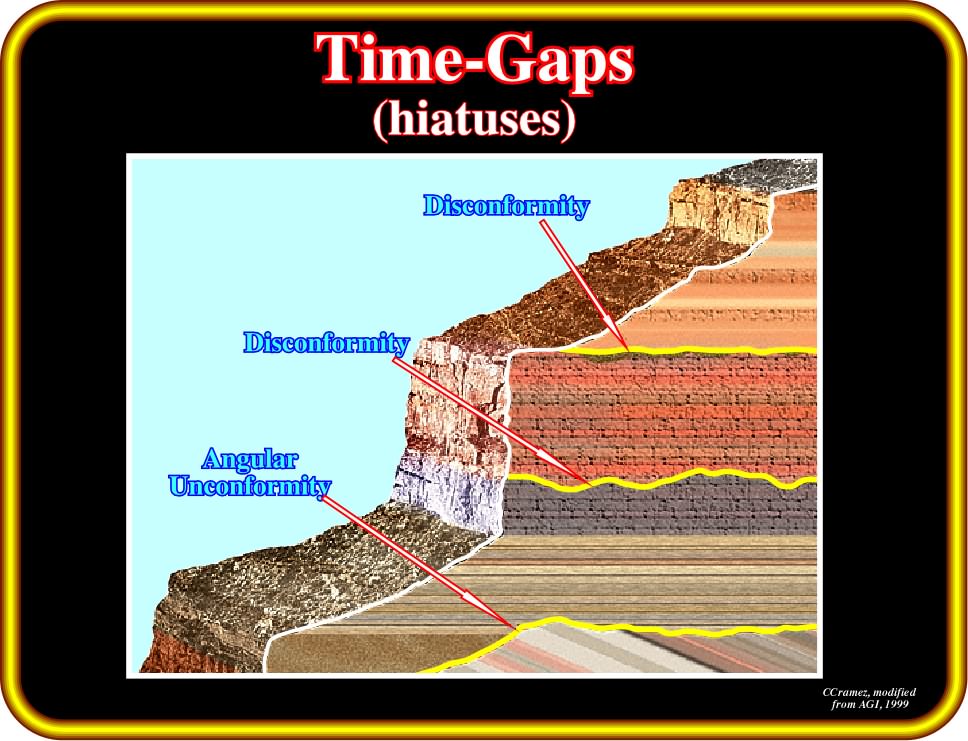
Plate 125- Time-gap surfaces can be bedding planes, when the time-gap is small, and unconformities or disconformities when the time-gap is significant. Unconformities can be tectonically enhanced (angular unconformities) or not. When they are not tectonically enhanced, unconformities are, sometimes, named disconformities as depicted above. On these notes, the term unconformity will be used for all erosional surfaces induced by significant relative sea level falls.
a.ii) Stratal discontinuities are physical surfaces caused by erosion or by non deposition :
(1) Unconformities ;
(2) Disconformities ;
(3) Depositional hiatuses.
Unconformity time-gaps may simply represent prolonged periods of sub-aerial exposure with minimal erosion, possibly with local valley or channel down-cutting, or they may represent periods of uplift and major sub-aerial erosion of strata or they may represent submarine erosion by turbidites, slump or submarine currents.
Classical sub-aerial unconformities are of two major types :
- Angular unconformities (Plate 126), with the discontinuity surface created by truncated strata beneath the boundary ;
- Disconformities (Plate 125) with beds parallel above and below the boundary.
A disconformity is often defined (Bates R. & Jackson, J., 1980) as an unconformity in which the bedding planes above and below the break are essentially parallel, indicating a significant interruption in the orderly sequence of sedimentary rocks, generally by a considerable interval of erosion (or sometimes of non-deposition, and usually marked by a visible and irregular or uneven erosion surface of appreciable relief
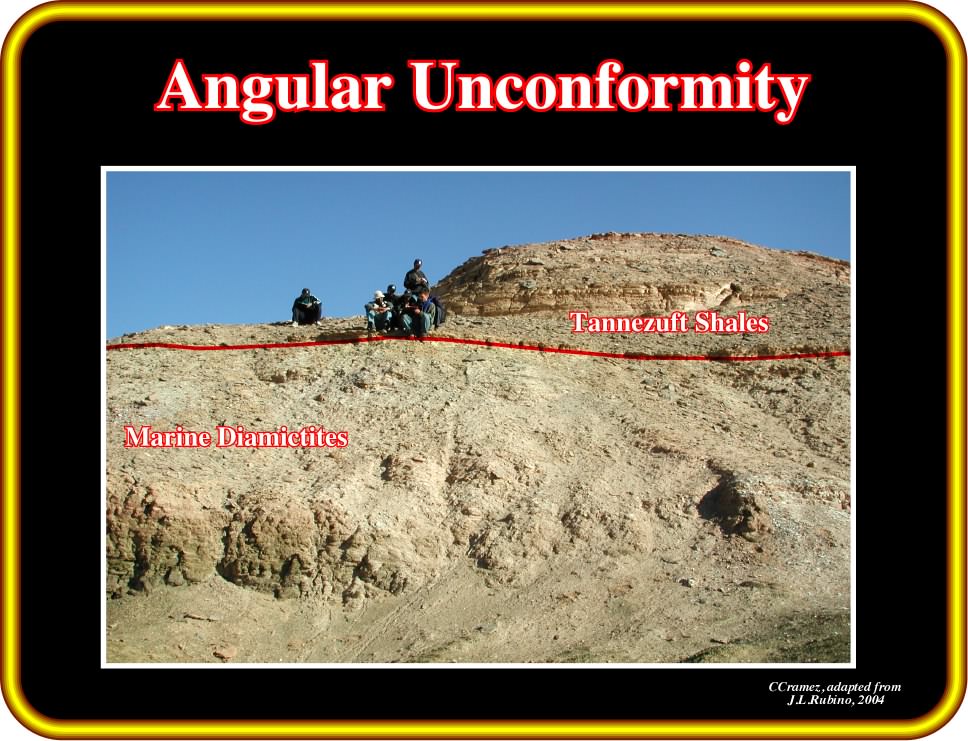
Plate 126- The stratal relationships (reflection termination on seismic lines), between the marine diamictites and the Tannezuft shales characterize an erosional surface, which created a large time-gap or hiatus, i.e., an unconformity between the sedimentary intervals. In addition, as we will see in next chapter (geometrical relationships) the stratal relationships are those associated with an angular unconformity.
Disconformities do not show discontinuity patterns. They are recognized either by paleontological evidence of a time-gap or by tracing regional discontinuity surfaces into the disconformity.
These classic unconformity types remain significant, but we also find discontinuity patterns of onlap (marine or lacustrine, transgression of the old sub-aerially exposed and gently tilted surface) and toplap (seaward rapid progradation of deltaic or bank-edge sediments from a common depositional surface) associated, commonly, with sub-aerial unconformities :
- Submarine unconformities have many of the same discontinuity patterns ;
- Truncation is created by turbidite and gravity-slump erosion of submarine valleys and canyons;
High energy submarine currents may also produce truncation patterns, although this is, usually, local and, rarely, removes consolidated sediments.
- Sub-aqueous non-depositional discontinuities are time-gaps caused by very slow deposition or by non-deposition.
a.iii) Diachronous surfaces are continuous physical boundaries that cross and are, essentially, independent of stratal boundaries. Stratal boundaries are, generally, non stratigraphic surfaces and are mentioned here because they are, sometimes, confused with stratal surfaces. Lithofacies and biozone boundaries may be synchronous, i.e., the particular lithofacies or biozone assembly is, laterally, continuous within synchronous stratigraphic surfaces. They may also be diachronous, i.e., they may step across stratal surfaces in a transgressive or regressive pattern.
Send E-mail to carloscramez@gmail.com or carlos.crame@bluewin.ch with questions or comments about these notes (Seismic-Sequential Stratigraphy).
Copyright © 2003 CCramez
Last modification: April, 2015